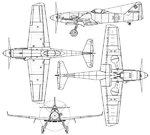This topic is abut the planes that were experimental and never saw action. You pick the top 3 that you would have liked to see in the fighting.Mine are the
XP60 WARHAWK a modified P-40 WARHAWK
XF5U CORSAIR A modified F4U CORSAIR
HEINKELL 100 a german fighter
What are you picks?
XP60 WARHAWK a modified P-40 WARHAWK
XF5U CORSAIR A modified F4U CORSAIR
HEINKELL 100 a german fighter
What are you picks?








